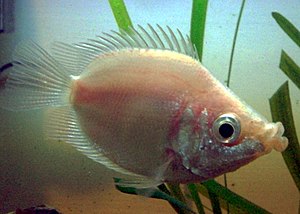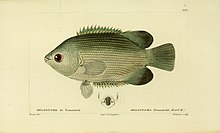Kissing gourami
| Kissing gourami | ||||||||||||
|---|---|---|---|---|---|---|---|---|---|---|---|---|

Kissing gourami ( Helostoma temminkii ) |
||||||||||||
| Systematics | ||||||||||||
|
||||||||||||
| Scientific name of the family | ||||||||||||
| Helostomatidae | ||||||||||||
| Gill , 1872 | ||||||||||||
| Scientific name of the genus | ||||||||||||
| Helostoma | ||||||||||||
| Cuvier , 1829 | ||||||||||||
| Scientific name of the species | ||||||||||||
| Helostoma temminkii | ||||||||||||
| Cuvier , 1829 |
The kissing gourami ( Helostoma temminkii ) is a large freshwater fish that is widespread in Southeast Asia and was the first labyrinth fish to be farmed as a livestock for meat production in ponds.
features
Kissing Guramis reach a total length of up to 30 centimeters. The body is clearly flattened laterally. The initially stretched young animals become tall-backed adults. From about the middle of the gill cover , the head tapers to the broad, fleshy mouth. There are small movable teeth on the bulging lips, while all other areas of the mouth and throat are toothless. This is where kissing guramis differ from all other labyrinth fish. On a silvery, gray or slightly olive green shimmering base color, evenly distributed narrow longitudinal stripes extend from the rear edge of the gill over the whole body, which are darker than the equally narrow spaces between them. The approach of the caudal fin is surrounded by a narrow ring in the color of the longitudinal stripes. All paired fins and the caudal fin are colorless and transparent. The dorsal and anal fin are toothed in the area of the hard rays; here the body color runs partially into the fin skins and forms a hem. The eye, which looks very large, is yellow-orange, sometimes red.
The largely inoperative for respiration gills are formed into a complex and delicate Reuse System, with the kissing Gouramis phytoplankton and zooplankton filtered from the water. Plankton makes up most of their natural diet. With their toothed, extendable lips, they suck tiny creatures out of sessile algae and grate plant leaves. Even larger insect larvae cannot use them. The lips also play an important role in comment behavior . It is expressed in a slightly aggressive, mutual pushing with the protruding lips that looks like a kiss. This kissing, not only on the mouth, but also on the flanks and stomach of the sexual partner, is also part of the courtship . External sexual characteristics do not exist. Females mature to spawn can be recognized by their abundance.
Fin formula : dorsal XVI – XVIII / 13–16, anal XIII – XV / 17–19.
Features of the xanthistic form
Probably in the course of its use as a commercial fish , an undefined and light-colored cultivated form was created which, due to the guanine reflection of the scales , appears predominantly white or pink, but is xanthistic . In xanthism, a recessively inherited lack of color, the dark pigment melanin is missing . Lipochromes deposited on the lipophores are responsible for the coloring of the body , pigment colors that are divided into xanthophores (yellow) and erythrophores (red). The complete lack of melanin eliminates the ability to change color. Color signals play an important role in the intraspecific communication of wild-colored kissing guramis. It is all the more astonishing that the cultivated form does not show any behavioral structures that deviate from the natural species and that both manifestations reproduce with one another without any problems. It is even more strange that the cultivated form survives permanently in natural waters and also reproduces successfully there. Usually, bright mutations in nature do not have a great chance of survival, because predators are immediately noticeable. Different colored morphs normally only assert themselves in natural populations if the coloring is not relevant. This is actually only the case with species that live in constant darkness (caves, deep sea ...). There are clear convergences here to color deficiency mutations in Central American and East African cichlids , which unfortunately have not yet been investigated either.
ecology
Since kissing guramis have been reproduced, raised and fattened in village ponds and pond farms for a long time , their exact origin can hardly be determined. The distribution extends today over Thailand including many islands, the Malay Peninsula and the large and small Sunda Islands . As a neozoon - expatriated, escaped from breeding farms or spread as spawn by water birds - kissing guramis now also live in the Philippines , Papua New Guinea , Australia , Colombia , the Caribbean , Canada and are also repeatedly detected in Florida . In nature, kissing guramis populate the flat bank zones of calm tributaries of rivers, stagnant waters and, after the rainy season, flood plains. Their habitats are bound to high water temperatures, strong sunlight and the resulting nutrient richness that they need as plankton eater. Kissing guramis do not form pairs, but rather larger social units that can be called schools.
Reproduction
Reproduction takes place under natural conditions after the rainy season . Males and females form a bond for this purpose only and only for the brief period of courtship and spawning. The spawning business, in which the partners twist around each other, can also take place within a larger group. Several thousand very small yellowish eggs are released per spawning phase , which are lighter than water, float to the surface and stick with their sticky shell to plant stems and leaves. The tiny larvae hatch within a day . They feed on their yolk supply for several days before they ingest the finest food particles (plankton, infusoria , floating detritus ...) for the first time . Kissing guramis do not care for the brood , not even indirectly through territorial defense .
Systematics
The generic name Helostoma was first mentioned in 1823 by Heinrich Kuhl and Conrad Jakob van Hasselt in connection with the description of Helostoma striolatum . The two young researchers had their base in Buitenzorg (now Bogor ) on the Sunda island of Java and reported their discoveries in letters to the Royal Academy of Sciences in Holland . Although they clearly defined recognizable species , their texts did not meet the requirements for scientific species descriptions, because the diagnoses required for this were mostly missing . For this reason the kissing gurami is not called Helostoma striolatum today , but according to the description of the species by Georges Cuvier Helostoma temminkii Cuvier 1829. This description was made according to the then valid regulations, but only in a footnote, which is why it was published two years later in a larger joint publication repeated in greater detail by Cuvier and Valenciennes . According to the priority principle, the description from 1829 is valid, but Helostoma temminckii Cuvier & Valenciennes 1831 is an invalid synonym description . By Pieter Bleeker : two more synonyms from 1845 originate Helostoma oligacanthum and Helostoma tambakkan . Also Helostoma rudolfi , 1931 by the Austrian biologist described Machan, belongs to the synonymy. Notably, all of these descriptions were made from fish gathered on Java. The holotype is lost. The monotypical genus Helostoma Cuvier & Valenciennes 1829 forms a separate family (Helostomatidae) within the suborder Anabantoidei (labyrinth fish ).
The generic name is made up of the ancient Greek words helos “hump” or “wart” (ἧλος - but not ἓλος “swamp”) and stoma “mouth” or “mouth”; it refers to the prominent and pronounced lips ("hump mouth"). The species name is a dedication in honor of the Dutch physician and naturalist Coenraad Jacob Temminck . The notation temminkii (without c) corresponding to the first description is the valid one.
Importance to humans
In Southeast Asia , the kissing gourami is a popular and important food fish that is boiled, breaded, deep-fried and baked. Most of the fish are offered live at markets. In nature, fishing is done with fish traps and nets . Most kissing guramis, however, are grown in village ponds, rice fields or commercial pond farms. There they are fattened with plant waste and manure (or with the microorganisms that feed on it). According to the FAO , almost 16,000 tons of fished and around 4,000 tons of kissing gouramis produced were marketed worldwide in 2007. In addition, tens of thousands of juvenile fish are bred as aquarium fish in Thailand and Malaysia every year . The xanthoristic cultivated form is predominantly in the trade, rarely albinos and piebald morphs. Specimens sprayed with fluorescent food coloring and a "balloon gourami" with a crippled spine are produced exclusively for the aquarium hobby; in the Federal Republic of Germany, trade in them is prohibited by the Animal Welfare Act .
literature
- Gosline, WA (1987): Jaw structures and movements in higher teleostan fishes . Ichthyological Research, 34 (1).
- Michael Kokoscha: Labyrinth Fish . Verlag Eugen Ulmer, Stuttgart 1998, ISBN 3-8001-7431-6 .
- Liem, KF (1967): Functional morphology of the head of the anbantoid teleost fish Helostoma temminckii . Journal of Morphology, 121 (2): 135-157.
- Jörg Vierke: Labyrinth fish . Franckh'sche Verlagshandlung W. Keller & Co., Stuttgart 1986, ISBN 3-440-05594-9 .
swell
- Alfred, ER (1961): The Javanese fishes described by Kuhl and van Hasselt . Bulletin of the Singapore National Museum No. 30: 80-88, Pls. 3-8.
- Kottelat, M. & E. Widjanarti (2005): The fishes of Danau Sentarum National Park and the Kapuas Lakes area, Kalimantan Barat, Indonesia . The Raffles Bulletin of Zoology Suppl. No. 13: 139-173
- Machan, B. (1931): New fish from Java . Display of the Academy of Sciences in Vienna v. 68 (no. 21): 221-222
- Roberts, TR (1993): The freshwater fishes of Java, as observed by Kuhl and van Hasselt in 1820-23 . Zoological Negotiations (Leiden) No. 285: 1-94.
- Roberts, TR (1989): The freshwater fishes of western Borneo (Kalimantan Barat, Indonesia) . Memoirs of the California Academy of Sciences No. 14: i-xii + 1-210.
- Tan, HH & PKL Ng (2005): The labyrinth fishes (Teleostei: Anabantoidei, Channoidei) of Sumatra, Indonesia . The Raffles Bulletin of Zoology Suppl. No. 13: 115-138.
Individual evidence
- ↑ Cuvier, G. (1829): Le Règne Animal, distribué d'après son organization, pour servir de base à l'histoire naturelle des animaux et d'introduction à l'anatomie comparée , 2nd v. 2: i-xv + 1-406.
- ^ Cuvier, G. & A. Valenciennes (1831): Histoire naturelle des poissons. Tome septième. Livre septième. Of the Squamipennes. Livre huitième. Des poissons à pharyngiens labyrinthiformes. Historie naturelle des poissons. Tome Sixième. v. 7: i-xxix + 1-531, Pls. 170-208.
- ^ Bleeker, P. (1845): Bijdragen tot de geneeskundige topography van Batavia. Generically overlooks the fauna . Natuuren Geneeskundig Archif voor Neerlandsch Indië v. 2: 505-528.
Web links
- Kissing Gurami on Fishbase.org (English)
- Economic data at the FAO
- Kissing Gurami in the CAS Catalog of Fishes
- Helostoma temminkii inthe IUCN 2013 Red List of Threatened Species . Listed by: Vidthayanon, C., 2012. Retrieved December 10, 2013.

